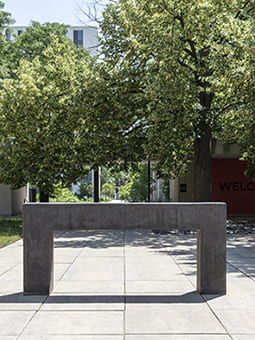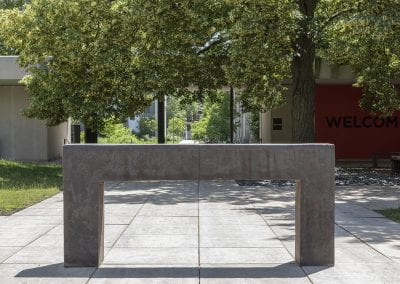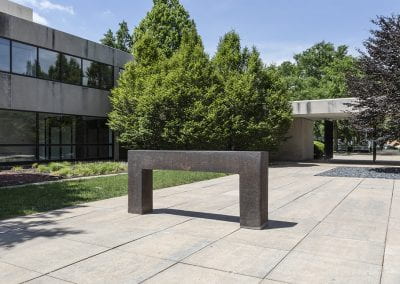Seattle Right Angles Propped
Richard Serra (1938–2024)

Created 1991
Installed 2019
Forged steel in two parts
43 1/2 × 96 × 12 1/8 in. (110.5 × 243.8 × 30.8 cm)
Located in the the Smart Museum of Art’s Vera and A. D. Elden Sculpture Garden
Smart Museum of Art, The University of Chicago, Gift of the Doris F. Sternberg family, 2018.75
The sculptures of Richard Serra lay bare the artistic and industrial activities behind their making. The American artist’s work—marked by untreated metal sculptures installed in a variety of rural landscapes and urban public spaces—is about process. With its raw steel surfaces, Seattle Right Angles Propped speaks directly to Serra’s interests in process-based art. Located at the center of the courtyard connecting the Smart Museum of Art and the University’s Cochrane-Woods Art Center, Seattle Right Angles Propped is an abrasive metal form, consisting of two L-shaped components that brace against one another and form a low bridge whose height reaches a viewer’s upper torso. Like the shape it forms, the courtyard sculpture also links two disparate periods of Serra’s practice: the artist’s early prop works with his later, large-scale and site-specific sculptures. Embracing these periods in tandem, Seattle Right Angles Propped embodies Serra’s radical conception of sculpture. The steel artwork is not an inert object but a structure that changes and must be encountered in motion, or in time.
Now nestled between the courtyard’s low porticos, Seattle Right Angles Propped once framed a very different location: overlooking Lake Michigan outside the home of art collector Dorie Sternberg and her late husband, Paul Sternberg in Glencoe, Illinois. Dorie Sternberg recalls Serra visiting the site with a to-scale cardboard maquette of the sculpture. Moving it around the yard to model potential installation sites, Serra settled on positioning the steel structure on the Sternbergs’ back lawn upon a bluff overlooking Lake Michigan and visible from the windows of their living room. Seattle Right Angles Propped was relocated in the spring of 2019, when the Sternbergs donated the sculpture to the University’s Smart Museum of Art—a fitting return, as Dorie Sternberg was born and raised on the South Side where she attended the University of Chicago’s Laboratory Schools.
Sources
Bois, Yve-Alain, and John Shepley. “A Picturesque Stroll around ‘Clara-Clara.’” October 29 (1984): 33-62.
Crimp, Douglas. “Redefining Site Specificity.” In Richard Serra, edited by Hal Foster, Gordon Hughes, and B. H. D. Buchloh. October Files. Cambridge, Mass: MIT Press, 2000.
Krauss, Rosalind E. “Richard Serra: Sculpture.” In Richard Serra: Sculpture, edited by Rosalind E. Krauss, Richard Serra, Laura Rosenstock, and Douglas Crimp. New York: Museum of Modern Art, 1986.
Serra, Richard. Writings, Interviews. Chicago: University of Chicago Press, 1994.
Serra, Richard, and Hal Foster. Conversations About Sculpture. New Haven: Yale University Press, 2018.
Further Reading
Buchloh, Benjamin H.D. “Process Sculpture and Film in the Work of Richard Serra.” In Richard Serra, edited by Hal Foster, Gordon Hughes, and B. H. D. Buchloh. October Files. Cambridge, Mass: MIT Press, 2000.
McShine, Kynaston, Richard Serra, and Lynne Cooke. Richard Serra: Sculpture: Forty Years. New York: Museum of Modern Art : Distributed in the United States and Canada by D.A.P./Distributed Art Publishers, 2007.
Gallery
Click on the image to zoom in


